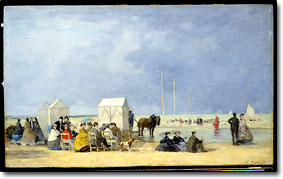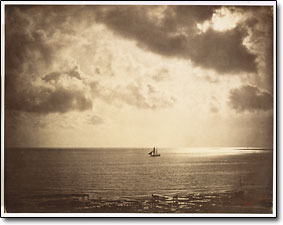|
See a video of UMMA’s Carole McNamara talking about the exhibit > |
Some claim there is little left to know about Impressionism, the iconic 19th-century art movement with distinctively dreamy canvasses that continue to shape contemporary sensibilities.

Yet the lasting impact of the style that integrates a reverence for light, visible brush strokes and open composition might be more in tune with contemporary realities than has been realized, according to Carole McNamara, senior curator of Western art at the U-M Museum of Art.
She began with the simple question: What was the stylistic inspiration for James McNeill Whistler’s “Sea and Rain,” a seminal Impressionist painting in UMMA’s collection. Rather than follow a narrow path, McNamara discovered how artists were responding to the interplay of cultural influences coalescing in mid-19th-century along the Normandy coast in France, where Whistler painted.
Since that initial inquiry, McNamara has spent nearly a decade assembling a case to re-evaluate the impact of photography on the movement’s greatest artists, including Whistler, Claude Monet, Gustave Courbet, Edouard Manet and Edgar Degas.
“The Lens of Impressionism: Photography and Painting Along the Normandy Coast, 1850-1874,” curated by McNamara, presents vivid juxtapositions of the hauntingly beautiful mid-19th century photography of Gustave Le Gray, Henri Le Secq, and other lesser-known artists alongside works of Impressionist masters in a thoughtful evocation of the roots of the popular movement. The exhibition opens Oct. 10 and runs through Jan. 3.

After gazing at Monet’s or Courbet’s work, it’s a short step to grasp how photographers’ quest to “arrest motion” became aesthetically valid and how instantaneity captured their imagination, McNamara says.
“Along with the major inventions of the day — train, telegraph and photography — artists were dealing with how the whole notion of time was upended,” she says. “Many of these artists saw how a photograph was an immediate way to capture motion.”
McNamara traced the American-born Whistler’s trip to France’s Normandy coast, where he and fellow artist Courbet traveled in a region that became one of the greatest tourists’ attractions in the world. In contrast to Courbet’s broad-stroke paintings, Whistler was moving away from realism, experimenting with a gossamer-like style and chromatically narrow palette. For McNamara, the influence of photography on Whistler was underestimated.
In the years following the invention of photography in 1839, a rigorous discussion commenced about whether “taking pictures” was a fine art, or simply mechanical documentation. McNamara points to the calm beauty of Le Gray’s “The French Fleet, Cherbourg” (1858), an albumen print, as evidence the pre-eminent photographers of the day were unquestionably first-rate artists.
The symbiotic relationship between photography and painting is noteworthy when considering the many visual images appropriated by contemporary artists. What is an original vision — or an authentic image — in the digital age is getting more difficult to discern.
Following its showing in Ann Arbor, the exhibition will travel to the Dallas Museum of Art.

